I am super-excited about a fabulous plant that has taken my fancy – it is called Tillandsia stricta, an air plant.
Tillandsia Stricta belongs to the Bromeliaceae family, according to Stellenbosch University.
This is the Bromeliad family.
Tillandsia stricta is THE perfect plant for those who believe they don’t have green fingers.
It grows in fresh air! This is a plant that does not need any soil and does not even need a pot.
Sounds unbelievable? Read on for more information.
Tillandsia stricta is also known as Strict Tillandsia, Tillys, Air Plant, Airplant, Erect Tillandsia, or Upright Air Plant.
It is native to Trinidad, Guyana, Suriname, Bolivia, Paraguay, Venezuela, Brazil, Argentina, and Uruguay.
In its natural habitat, it grows amongst rocks, in crevices of tree branches, or nestled between the leaves of other plants.
Tillandsia is a genus that contains about 650 species, of which one is the everyday pineapple.
The origin of this plant’s scientific name, stricta, means ‘erect’. This describes the upright growing habit.
Tillandsia stricta makes a fabulous addition to any indoor space that is crying out for a touch of nature.
It offers evergreen, long silvery-blue leaves and glorious blooms of rosy red with hints of blue.
Tillandsia stricta Care
To care for Tillandsia place it into a decorative container with no soil. Attach it firmly and place it in a position with bright indirect light and sufficient airflow. Water the plant by submerging it once a week in a bowl of lukewarm water. Allow it to dry out fully within 3 to 4 hours. Fertilize once a month with a liquid fertilizer at 1/4 of the normal strength. Provide medium humidity around 40-50% and a temperature between 50°F to 90°F (10°C to 32°C).
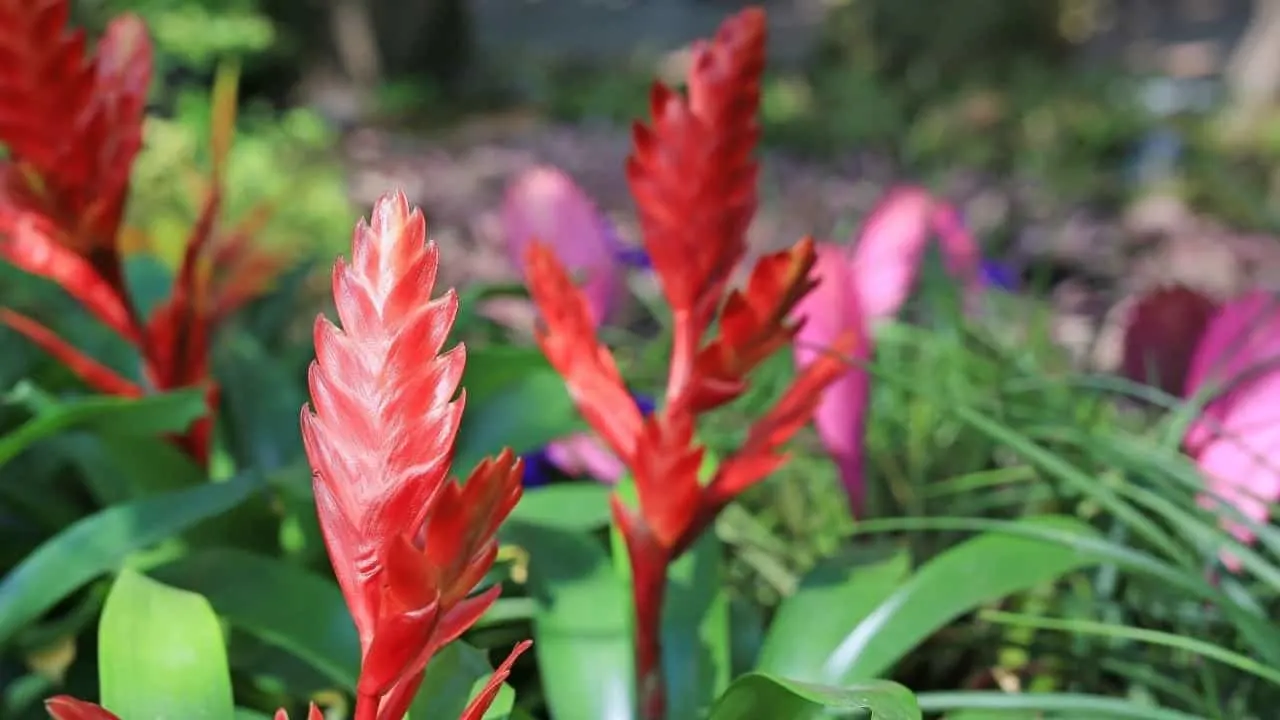
Table of Contents
Tillandsia stricta Care Guide
Soil
Tillandsia stricta does not need soil to grow.
his plant survives on water, light, and fresh air.
It has no roots that grow into the soil.
The roots that it will start to develop are merely to attach it to branches of trees.
So, no worrying about the right mix of well-drained, moist, or gritty soil. And, you will have clean hands after doing your gardening.
Light
Provide Tillandsia stricta with bright indirect light.
Being an air plant, giving your Tillandsia stricta the correct amount of light is vital.
Light is one of the main factors that keep it alive, healthy and flourishing.
Place your plant in a spot that has bright filtered light or indirect light.
Direct sun is not ideal, but it can deal with some direct sun for a short time every day.
An hour in the morning is good. Your plant should not bake all day in the hot sun.
Too much direct sunlight can cause sunburn and create brown, unsightly marks on the plant.
You can grow your Tillandsia stricta in darker rooms using artificial light. This is great for those in-city apartments that don’t get much sun.
Full-spectrum artificial light, also known as fluorescent light, is best.
Place your plant 6 inches to 35 inches (15cm to 35cm) from the light if possible.
It can tolerate up to 12 hours of this light per day.
Tillandsia stricta also grows well outdoors. Look for a bright spot with indirect light and a few hours of direct sun per day.
Tillandsia stricta light care tip: Don’t keep your air plant in the dark. It enjoys bright light and a few hours of direct sun.
Watering
Water Tillandsia stricta by submerging it in lukewarm water for 30 minutes and let it dry upside down for 3-4 hours.
Tillandsia stricta is a hardy plant, but it does love water.
Air plants absorb nutrients and moisture through their leaves and not through their roots like other plants.
They have a system of trichomes, that look like little sponges on the leaves that it uses for absorption.
In its natural habitat, water is obtained from rain that washes over the leaves and from water that collects in the crevices where the plant grows.
For your indoor plant, thoroughly soak it once a week.
Do this more often if you have it in a hot, dry environment. Do it less often if the plant is in a humid spot.
Carefully remove the plant from its container or display, and fully submerge into a bowl of water for a few hours.
Shake it off and allow them to dry out fully before replacing into your display.
If the plant has a flower, do not submerge the bloom.
If you are using tap water, allow it to stand for a while to dissipate the chlorine.
Also, ensure that it is not too icy cold.
Room temperature will be fine. You can also use pond water, aquarium water, or even rainwater if you can collect some.
Place your plant in a spot to dry that has bright light and air circulation, but is not in direct sunlight.
You don’t want the plant to dry out too fast, else it cannot absorb enough water for its hydration needs.
Spray misting is also a great way to water your plant if you don’t have enough time to submerge it.
You can also do this between full waterings to give the plant moisture. Allow to dry out after spraying.
Tip for best Tillandsia stricta watering care: It is preferable to water in the morning rather than at night.
These plants use CAM (Crassulacean acid metabolism) photosynthesis. This sounds very complex, but it is not.
Most plants absorb carbon dioxide from the air during the day. Airplants do this at night.
If the plant is wet at night, it won’t be able to breathe.
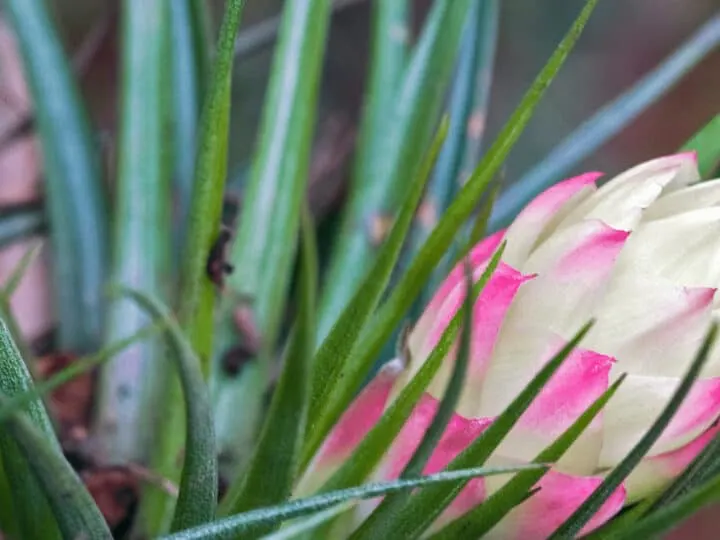
Temperature
The best temperature for Tillandsia stricta is 50°F to 90°F (10°C to 32°C).
Try to ensure that your plant does not endure nighttime temperatures below 39°F (4°C), especially if it is wet.
If it is in a sheltered spot and the leaves are dry, it can withstand colder temperatures for a few hours without fatal damage.
Generally, they are not happy in very cold conditions and will not tolerate frost.
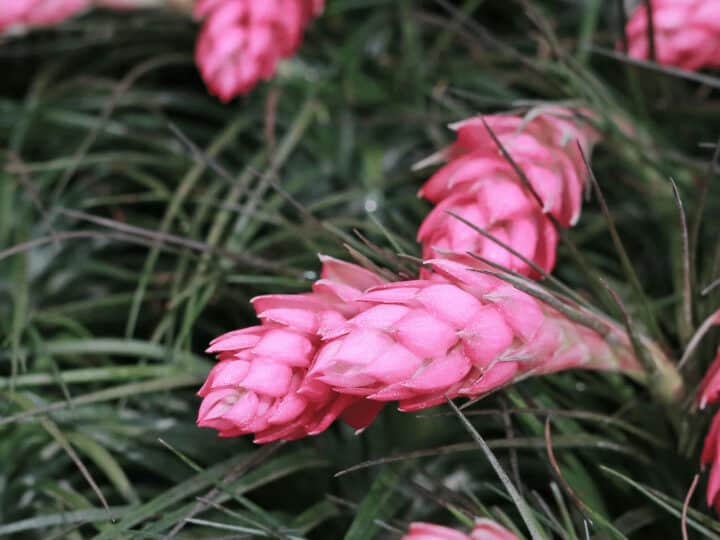
Humidity
Humidity is the amount of dampness or moisture in the air. Tillandsia stricta enjoys a moderate to low level of humidity between 40-50%.
Although it wants to be wet often, it must be allowed to dry out fully between mist spraying or submerging.
You need to get a good balance that allows the plant to remain wet long enough for it to absorb water, but not too long so that it starts to rot and becomes susceptible to disease.
A drying period of a few hours should be adequate.
It is important to have good aeration for your Tillandsia stricta.
They require air that moves and is not closed up or stale.
Do not, however, place directly in front of an air conditioner or heater. No plant does well in a draught.
Tillandsia stricta care tip: If possible, move your Tillandsia stricta outdoors in the Summer into a shaded spot for a few hours.
It will benefit greatly from the fresh air.
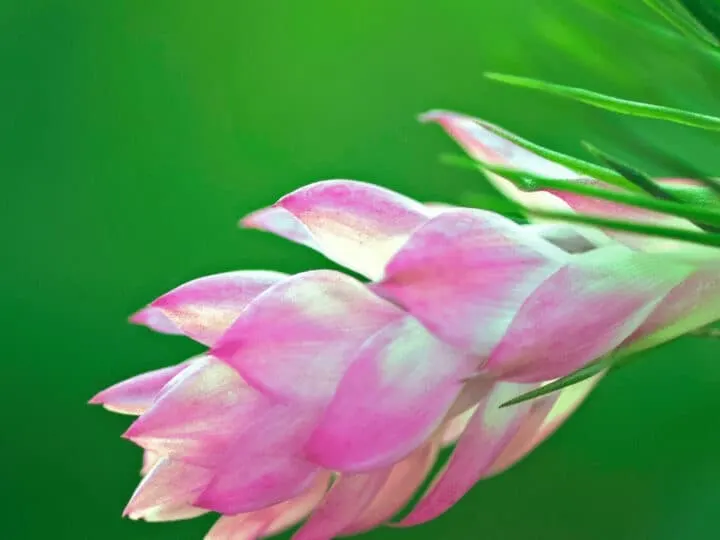
Fertilizer
Tillandsia stricta does not need excessive fertilizing and can be fertilized once a month during the growing season with a liquid fertilizer at 1/4 of the normal strength.
It can grow happily for months with very little care and attention, as long as it gets water, light, and fresh air.
You may be wondering how to fertilize a plant that is not planted into soil. Well, so was I!
The expert told me to use a water-soluble fertilizer and add it to the water used for submerging or mist spraying the plant.
I used 1/4 of the normal strength recommended on the package.
The fertilizer is absorbed into the leaves together with the water.
Fertilizing should be done once a month or less and only during the growing period.
Over-fertilizing will cause the plant to burn and may even cause it to die. Avoid high nitrogen fertilizers as these can prevent the plant from flowering.
You can also ask your nursery for a Bromeliad fertilizer and add that to the water in your spray bottle.
Bromeliads are a plant family that contains over 3000 described species, which include air plants.
Tillandsia stricta fertilizing care tip: If you are using aquarium water or pond water, you don’t need to fertilize your plant.
This type of water contains enough natural fertilizer.
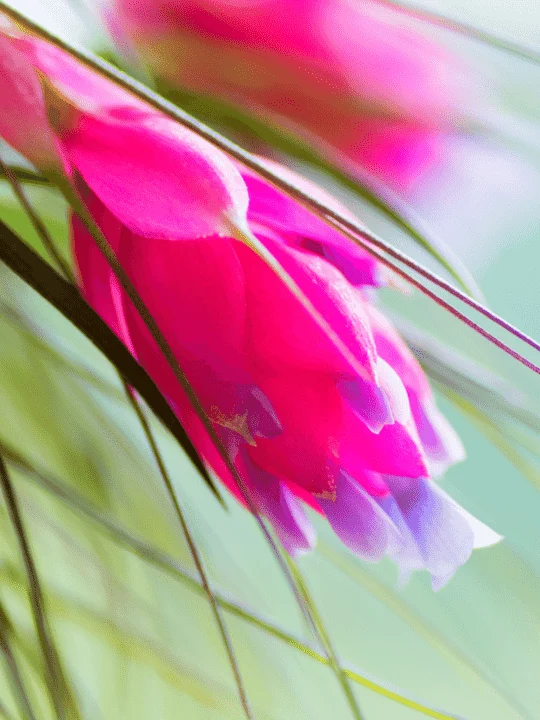
Propagation
Propagation of the Tillandsia stricta can be done via offsets.
A mature plant after blooming will produce pups, or offsets, at its base. If left alone, they will eventually grow into mother plants.
By separating them, you can create new plants without having to purchase more from the nursery.
Further on, I give a step-by-step process on how to do this. It is easy and fun, why not give it a try?
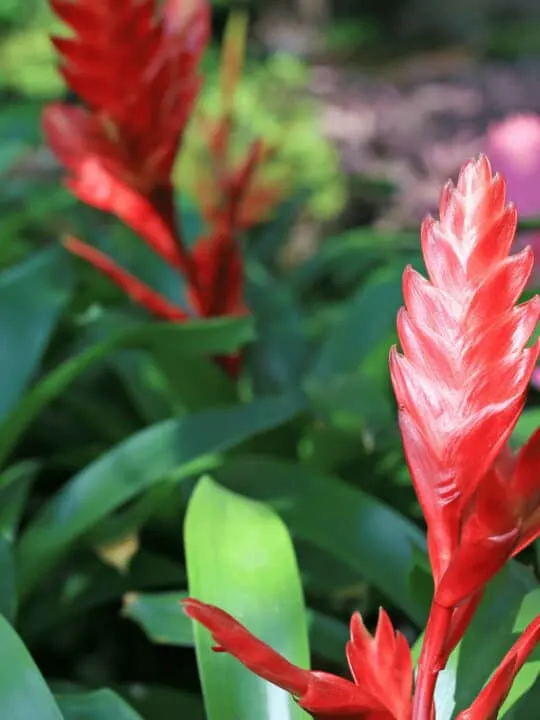
Growth
Tillandsia stricta is an evergreen short-stemmed plant that will grow to a size of around 4 inches (10cm) across and up to 8 inches (20 cm) high.
Tillandsia stricta plants come in a large number of variations. The one I have offers lovely soft silvery-blue leaves. Some varieties have leaves that are greener and stiffer.
When the plant is mature it produces a glorious funnel-shaped bloom of bright rose-red with spikes of bright blue flowers.
Flowers appear in early Summer. The flower initially stands upright but droops as it gets longer and heavier.
These flowers only last around a day or so, before they start to wilt. Flowers are around 0.5 inch to .75 inch (1.5cm to 2cm) long.
The plant has a clumping habit. It grows by forming a mound or thicket and grows outwards from the center, maintaining a compact shape.
Covering the leaves are frost-like scales known as trichomes. These are used to absorb water and nutrients in place of the roots.
Your plant may grow roots and use them to anchor it to a host.
The anchor may be the container, tree branch, or another plant, depending on how you have potted it.
Potting
Potting your airplant is unlike potting any other plant. You do not need a pot and you do not need soil. You need to get creative!
The plant grows as an epiphyte on anything that will support it.
Your air plant can grow in a beautiful glass globe, on a piece of driftwood, or in a seashell. You can hang them from a wire frame on a wall, or even place them into the spokes of an antique bicycle wheel.
Classic terrariums are great for showing off your air plants.
You can position your Tillandsia stricta between the rocks in a small indoor rock garden.
They look great in twisted metal shapes, on holders used for candles, or even in decorative bird cages.
Why not create your own spheres using string, wire, or strips of wood, and place the airplant inside for a wow look?
Make sure that your plant rests comfortably and securely in the display you choose. You don’t want it falling out.
Some types of metal can be toxic to air plants, especially when the metal is often wet.
To solve this problem, you can seal the metal with a clear coating product from your local hardware store.
If you are planting into a seashell, make sure to empty out the shell after watering.
Tillandsia stricta will not survive if it stands in water for long periods of time.
Tillandsia stricta potting care tip: If your plant is in a terrarium do not place it in direct sunlight as the glass can magnify the heat.
Moving it occasionally to a shady outdoor spot is a great booster for your plant.
Tillandsia stricta in-depth propagation guide
Propagate from offsets
- After your air plant has matured and bloomed, it will grow pups at its base.
- These pups can be separated from the mother plant and used to create new plants.
- Before removing them, allow the pups to grow to one-third or half the size of the mother plant.
- As far as timing goes, it is best to do the separation in the morning
- Remove your mother plant from its container or display
- Place into a bowl of water for a few hours
- Remove and place onto a clean, dry work surface
- Gently work the leaves apart until you have exposed the pups at the base
- Using your fingers, pull the pups off the main plant
- Use a gentle twisting motion if needed
- Place each pup into the water bowl to hydrate as it is separated.
- Remount your main plant
- Mount the pups in their new containers
- For the first couple of weeks, mist the pups with a light spray in the morning.
- Do not spray at night, the plant breathes at night and if the leaves are covered with water they cannot absorb the air.
Common problems with Tillandsia stricta
Pest Control
Tillandsia stricta will become susceptible to pests if it is placed in a continually damp and dark spot. The plant needs light and fresh air.
Air plants may get attacked by mealybugs. These pests will feed off the juices and eventually destroy the plant.
Use a spray of water to wash away the pests. If the infestation persists, mix a chemical-free insecticidal soap into your spray or your water bath.
Rotting roots
Tillandsia stricta does not enjoy having its roots submerged in water. They will rot and the plant will eventually die.
The airplant can be potted into a variety of containers including glass globes, seashells and the like.
These abstract containers won’t have your usual plant pot drainage holes. Ensure that after watering, you pour any excess water at the base of your container or display.
Leaves wilt and turn brown
This is a sign of too little water. Air plants need to be hydrated regularly either by submerging in a water bath or by mist spraying.
Plant falls apart
This is a sign of too much water. Like all things in life, too much and too little is not good. Reduce the amount of water you are giving your plant.
Try to move it outdoors for some direct sun and fresh air for a few hours.
Make sure that after watering, the moisture is not collected in the center of the plant.
If it is, reposition your plant so that the water can naturally flow off.
Tips to grow Tillandsia stricta problem-free
- Do not plant into any soil!
- This plant grows in air.
- Place into a decorative container and ensure it is firmly supported
- Place in a bright well, lit spot with about an hour of direct sun per day
- Water by submerging into a bowl of water for 3 to 4 hours
- Allow to dry off fully in around an hour or so
- Drying too fast won’t allow the plant to absorb enough water
- Mist spray from time to time
- Do not overhandle
- Fertilize only during the growing season
Toxicity
Air plants are pet-friendly houseplants for cats and dogs. They are also safe for animals.
Frequently Asked Questions
Is Tillandsia stricta a parasite?
Tillandsia stricta is not a parasite. The plant grows as an epiphyte on anything that will support it. They grow roots and use them to attach themselves to stems of other plants, branches of trees, or even rocks. This is done to anchor the plant. They will not absorb nutrients from a living host, nor will they kill the host.
Can Tillandsia stricta grow in artificial light?
Full-spectrum artificial light, also known as fluorescent light works great for Tillandsia stricta. Place your plant 6 inches to 35 inches (15cm to 35cm) from the light if possible. It can tolerate up to 12 hours of this light per day.
Does Tillandsia stricta require a lot of care?
Tillandsia stricta does not require too much care. It is pretty happy to be left alone. As long as it gets a good spray of water every now and then, fresh air, and lots of light, it will grow happily and look gorgeous.
Is Tillandsia stricta frost resistant?
Tillandsia stricta is not frost resistant. It enjoys warmer, relatively humid climates. If you live in a cold climate, consider growing your Tillandsia stricta indoors, where you can ensure that the temperatures remain between 50°F to 90°F (10°C to 32°C).
Conclusion
Tillandsia stricta is a super cool plant – I mean who cannot love a plant that grows in fresh air! It is great for beginners as it is hardy and easy to maintain.
As long as you have it in a suitable display in bright light, with fresh air and regular watering, it will grow happily.
When mature, the plant offers a charming display of silver-blue leaves and stunning rose-red blooms. You can also enhance your plant by creating exotic containers to display it.
I have recently added another Tillandsia air plant to my collection. It is the Tillandsia crocata.
This variety has gray-green leaves, yellow flowers, and a wonderful fragrance.

Daniel has been a plant enthusiast for over 20 years. He owns hundreds of houseplants and prepares for the chili growing seasons yearly with great anticipation. His favorite plants are plant species in the Araceae family, such as Monstera, Philodendron, and Anthurium. He also loves gardening and is growing hot peppers, tomatoes, and many more vegetables.

![Tillandsia Stricta Care Made Easy [#1 Best Tips]](https://plantophiles.com/wp-content/uploads/2021/02/Tillandsia-Stricta-Care-720x405.jpg.webp)
